Dissertation Proposal: The Importance of Corporate Philanthropy
VerifiedAdded on 2023/06/10
|58
|15668
|456
AI Summary
This dissertation proposal explores the declining trend of corporate philanthropy in the United States and its impact on nonprofit organizations. It delves into the concept of corporate philanthropy, its legitimacy, and the ongoing debate surrounding corporate social responsibility. The proposal examines various types of corporate philanthropy, including employee matching gifts, volunteer grants, and challenge grants. It also discusses relevant theories and models such as Carroll's CSR Model, Ackerman's Model, and the Intersecting Circles Model of CSR. Furthermore, the research investigates the relationship between philanthropy and financial performance, the strategies of conglomerate companies, and the effects of declining corporate philanthropy on nonprofit organizations, drawing on political and ethical theories to provide a comprehensive analysis. The document also highlights how Desklib provides a platform for students to access similar documents and past papers.
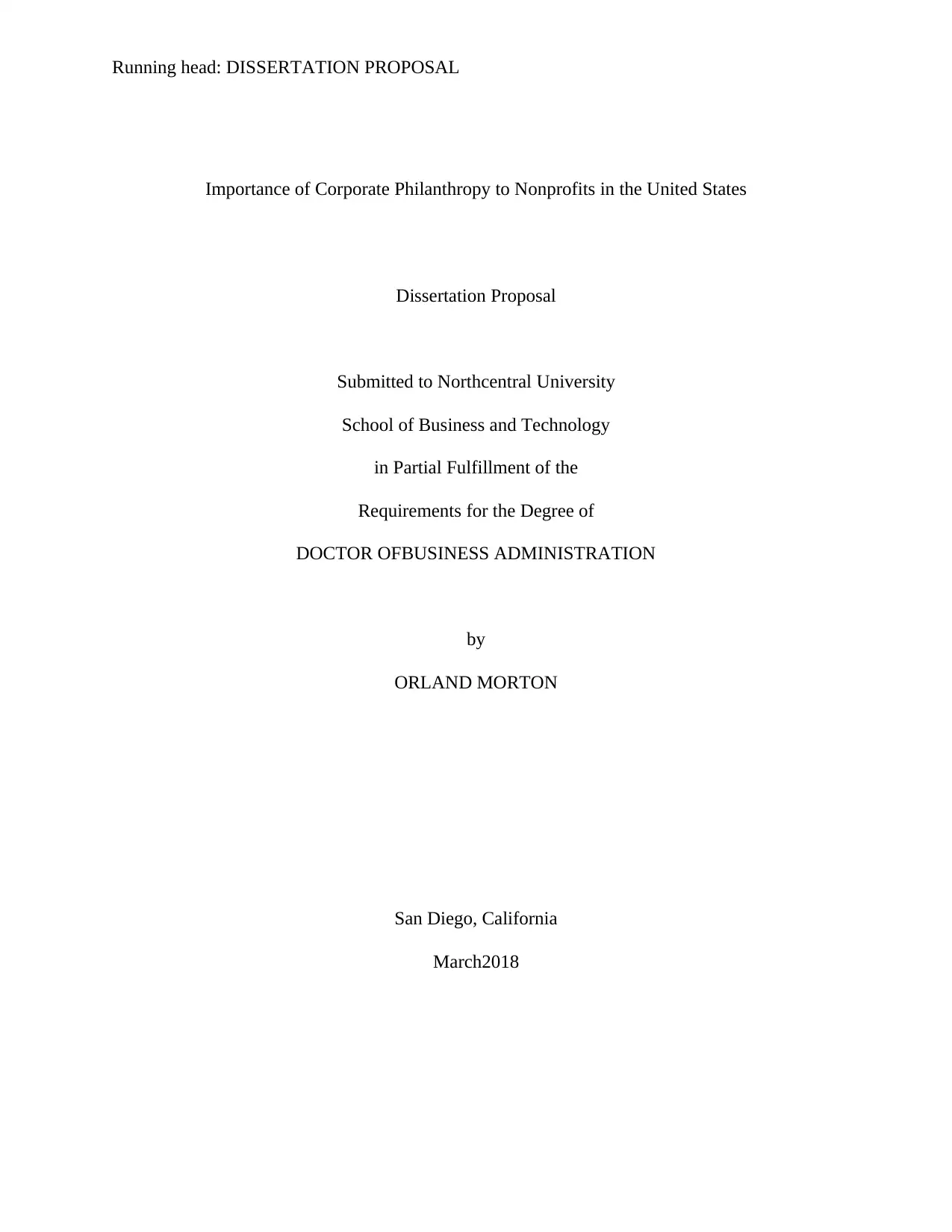
Running head: DISSERTATION PROPOSAL
Importance of Corporate Philanthropy to Nonprofits in the United States
Dissertation Proposal
Submitted to Northcentral University
School of Business and Technology
in Partial Fulfillment of the
Requirements for the Degree of
DOCTOR OFBUSINESS ADMINISTRATION
by
ORLAND MORTON
San Diego, California
March2018
Importance of Corporate Philanthropy to Nonprofits in the United States
Dissertation Proposal
Submitted to Northcentral University
School of Business and Technology
in Partial Fulfillment of the
Requirements for the Degree of
DOCTOR OFBUSINESS ADMINISTRATION
by
ORLAND MORTON
San Diego, California
March2018
Paraphrase This Document
Need a fresh take? Get an instant paraphrase of this document with our AI Paraphraser
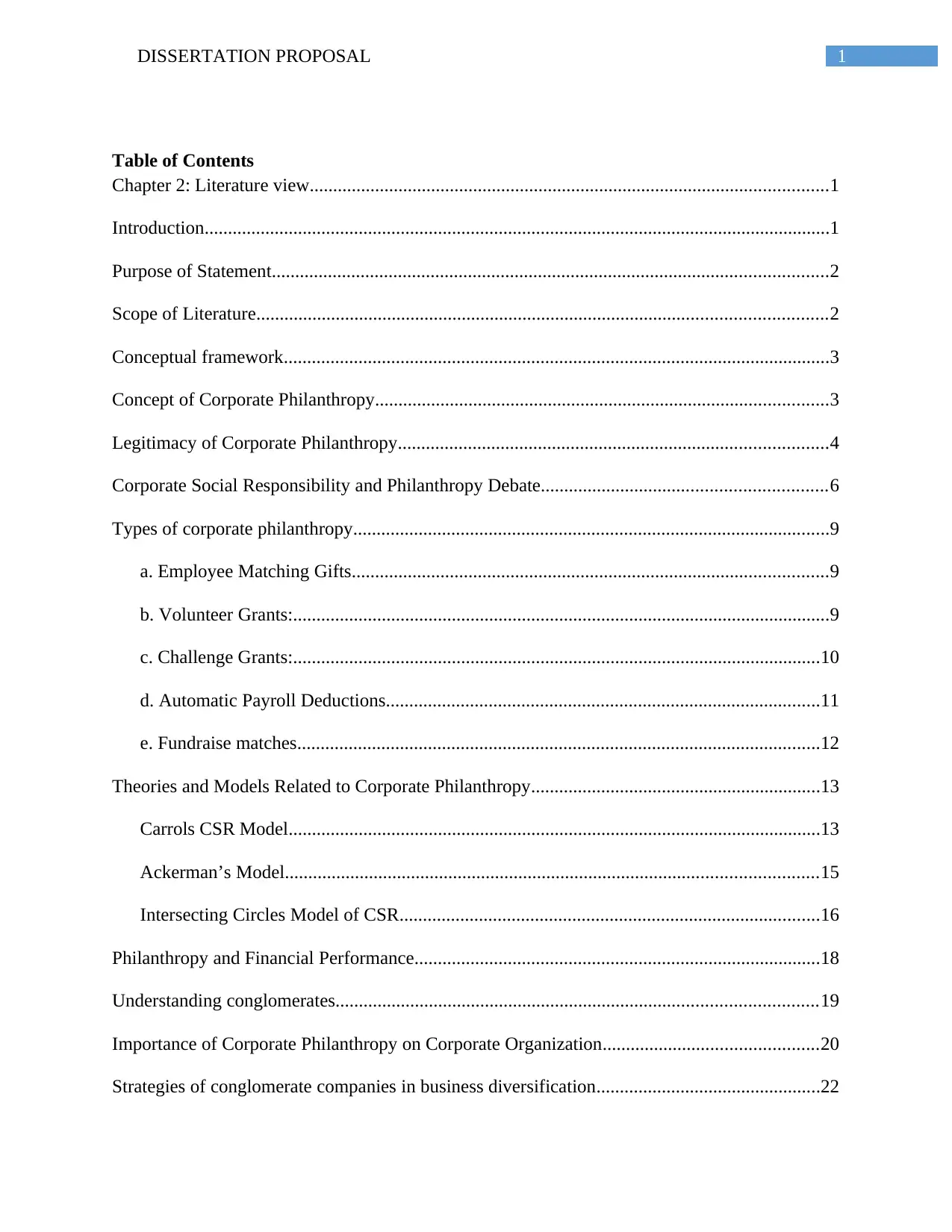
1DISSERTATION PROPOSAL
Table of Contents
Chapter 2: Literature view...............................................................................................................1
Introduction......................................................................................................................................1
Purpose of Statement.......................................................................................................................2
Scope of Literature..........................................................................................................................2
Conceptual framework.....................................................................................................................3
Concept of Corporate Philanthropy.................................................................................................3
Legitimacy of Corporate Philanthropy............................................................................................4
Corporate Social Responsibility and Philanthropy Debate.............................................................6
Types of corporate philanthropy......................................................................................................9
a. Employee Matching Gifts......................................................................................................9
b. Volunteer Grants:...................................................................................................................9
c. Challenge Grants:.................................................................................................................10
d. Automatic Payroll Deductions.............................................................................................11
e. Fundraise matches................................................................................................................12
Theories and Models Related to Corporate Philanthropy..............................................................13
Carrols CSR Model..................................................................................................................13
Ackerman’s Model..................................................................................................................15
Intersecting Circles Model of CSR..........................................................................................16
Philanthropy and Financial Performance.......................................................................................18
Understanding conglomerates.......................................................................................................19
Importance of Corporate Philanthropy on Corporate Organization..............................................20
Strategies of conglomerate companies in business diversification................................................22
Table of Contents
Chapter 2: Literature view...............................................................................................................1
Introduction......................................................................................................................................1
Purpose of Statement.......................................................................................................................2
Scope of Literature..........................................................................................................................2
Conceptual framework.....................................................................................................................3
Concept of Corporate Philanthropy.................................................................................................3
Legitimacy of Corporate Philanthropy............................................................................................4
Corporate Social Responsibility and Philanthropy Debate.............................................................6
Types of corporate philanthropy......................................................................................................9
a. Employee Matching Gifts......................................................................................................9
b. Volunteer Grants:...................................................................................................................9
c. Challenge Grants:.................................................................................................................10
d. Automatic Payroll Deductions.............................................................................................11
e. Fundraise matches................................................................................................................12
Theories and Models Related to Corporate Philanthropy..............................................................13
Carrols CSR Model..................................................................................................................13
Ackerman’s Model..................................................................................................................15
Intersecting Circles Model of CSR..........................................................................................16
Philanthropy and Financial Performance.......................................................................................18
Understanding conglomerates.......................................................................................................19
Importance of Corporate Philanthropy on Corporate Organization..............................................20
Strategies of conglomerate companies in business diversification................................................22
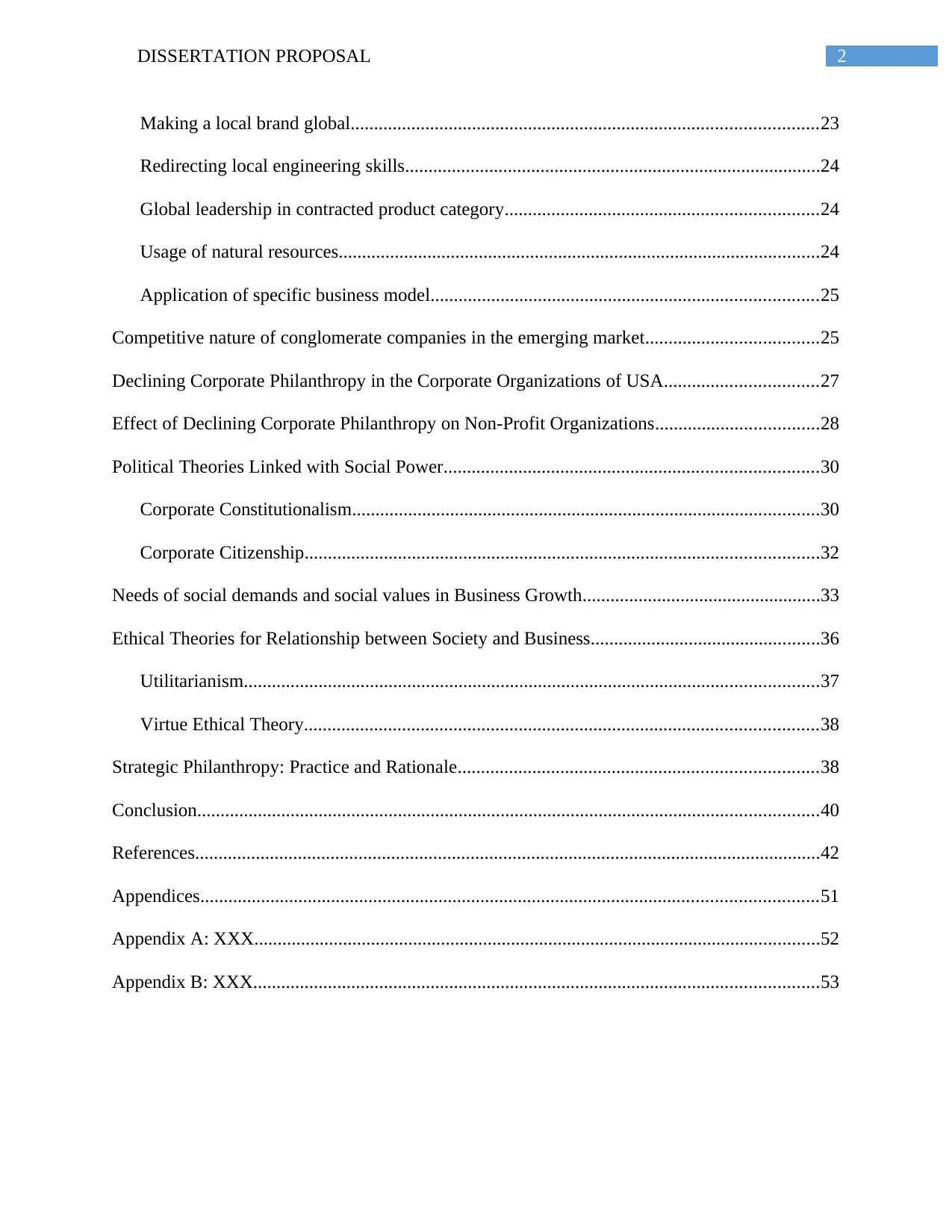
2DISSERTATION PROPOSAL
Making a local brand global....................................................................................................23
Redirecting local engineering skills.........................................................................................24
Global leadership in contracted product category...................................................................24
Usage of natural resources.......................................................................................................24
Application of specific business model...................................................................................25
Competitive nature of conglomerate companies in the emerging market.....................................25
Declining Corporate Philanthropy in the Corporate Organizations of USA.................................27
Effect of Declining Corporate Philanthropy on Non-Profit Organizations...................................28
Political Theories Linked with Social Power................................................................................30
Corporate Constitutionalism....................................................................................................30
Corporate Citizenship..............................................................................................................32
Needs of social demands and social values in Business Growth...................................................33
Ethical Theories for Relationship between Society and Business.................................................36
Utilitarianism...........................................................................................................................37
Virtue Ethical Theory..............................................................................................................38
Strategic Philanthropy: Practice and Rationale.............................................................................38
Conclusion.....................................................................................................................................40
References......................................................................................................................................42
Appendices....................................................................................................................................51
Appendix A: XXX.........................................................................................................................52
Appendix B: XXX.........................................................................................................................53
Making a local brand global....................................................................................................23
Redirecting local engineering skills.........................................................................................24
Global leadership in contracted product category...................................................................24
Usage of natural resources.......................................................................................................24
Application of specific business model...................................................................................25
Competitive nature of conglomerate companies in the emerging market.....................................25
Declining Corporate Philanthropy in the Corporate Organizations of USA.................................27
Effect of Declining Corporate Philanthropy on Non-Profit Organizations...................................28
Political Theories Linked with Social Power................................................................................30
Corporate Constitutionalism....................................................................................................30
Corporate Citizenship..............................................................................................................32
Needs of social demands and social values in Business Growth...................................................33
Ethical Theories for Relationship between Society and Business.................................................36
Utilitarianism...........................................................................................................................37
Virtue Ethical Theory..............................................................................................................38
Strategic Philanthropy: Practice and Rationale.............................................................................38
Conclusion.....................................................................................................................................40
References......................................................................................................................................42
Appendices....................................................................................................................................51
Appendix A: XXX.........................................................................................................................52
Appendix B: XXX.........................................................................................................................53
⊘ This is a preview!⊘
Do you want full access?
Subscribe today to unlock all pages.

Trusted by 1+ million students worldwide

3DISSERTATION PROPOSAL
List of Tables
Table 1: Factors constructing Corporate Philanthropy
List of Tables
Table 1: Factors constructing Corporate Philanthropy
Paraphrase This Document
Need a fresh take? Get an instant paraphrase of this document with our AI Paraphraser

4DISSERTATION PROPOSAL
List of Figures
Figure 1: Factors constructing Corporate Philanthropy
Figure 2: Conceptual Framework
List of Figures
Figure 1: Factors constructing Corporate Philanthropy
Figure 2: Conceptual Framework
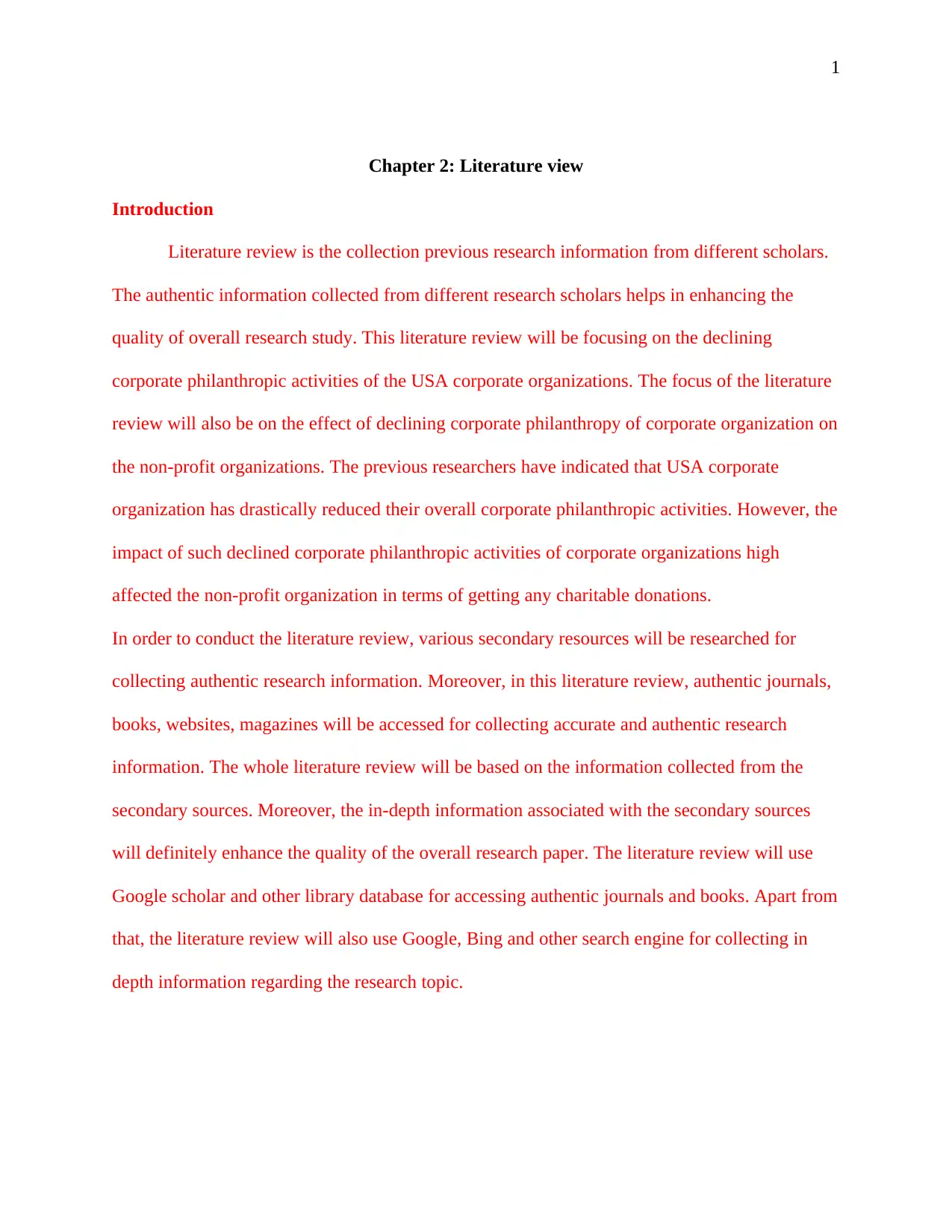
1
Chapter 2: Literature view
Introduction
Literature review is the collection previous research information from different scholars.
The authentic information collected from different research scholars helps in enhancing the
quality of overall research study. This literature review will be focusing on the declining
corporate philanthropic activities of the USA corporate organizations. The focus of the literature
review will also be on the effect of declining corporate philanthropy of corporate organization on
the non-profit organizations. The previous researchers have indicated that USA corporate
organization has drastically reduced their overall corporate philanthropic activities. However, the
impact of such declined corporate philanthropic activities of corporate organizations high
affected the non-profit organization in terms of getting any charitable donations.
In order to conduct the literature review, various secondary resources will be researched for
collecting authentic research information. Moreover, in this literature review, authentic journals,
books, websites, magazines will be accessed for collecting accurate and authentic research
information. The whole literature review will be based on the information collected from the
secondary sources. Moreover, the in-depth information associated with the secondary sources
will definitely enhance the quality of the overall research paper. The literature review will use
Google scholar and other library database for accessing authentic journals and books. Apart from
that, the literature review will also use Google, Bing and other search engine for collecting in
depth information regarding the research topic.
Chapter 2: Literature view
Introduction
Literature review is the collection previous research information from different scholars.
The authentic information collected from different research scholars helps in enhancing the
quality of overall research study. This literature review will be focusing on the declining
corporate philanthropic activities of the USA corporate organizations. The focus of the literature
review will also be on the effect of declining corporate philanthropy of corporate organization on
the non-profit organizations. The previous researchers have indicated that USA corporate
organization has drastically reduced their overall corporate philanthropic activities. However, the
impact of such declined corporate philanthropic activities of corporate organizations high
affected the non-profit organization in terms of getting any charitable donations.
In order to conduct the literature review, various secondary resources will be researched for
collecting authentic research information. Moreover, in this literature review, authentic journals,
books, websites, magazines will be accessed for collecting accurate and authentic research
information. The whole literature review will be based on the information collected from the
secondary sources. Moreover, the in-depth information associated with the secondary sources
will definitely enhance the quality of the overall research paper. The literature review will use
Google scholar and other library database for accessing authentic journals and books. Apart from
that, the literature review will also use Google, Bing and other search engine for collecting in
depth information regarding the research topic.
⊘ This is a preview!⊘
Do you want full access?
Subscribe today to unlock all pages.

Trusted by 1+ million students worldwide
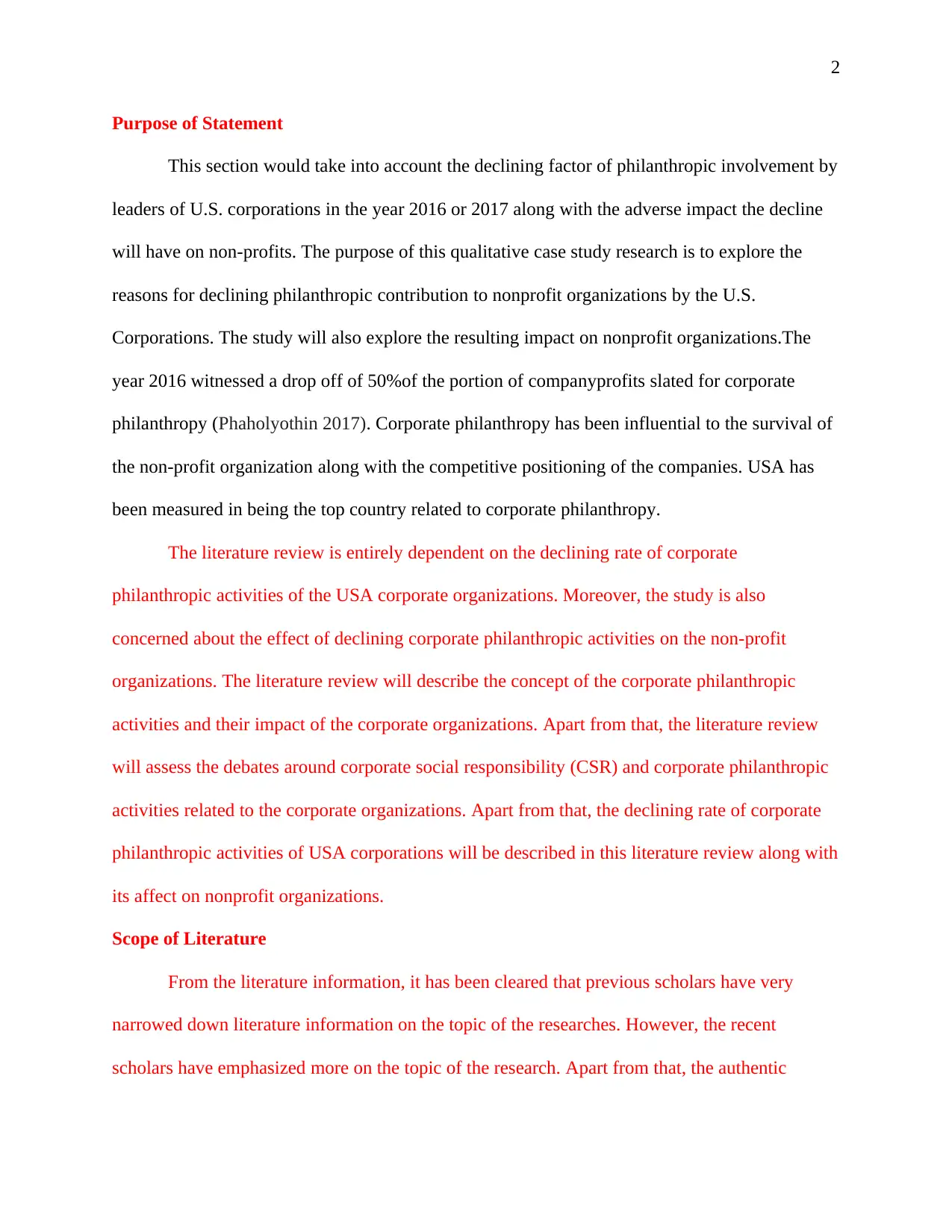
2
Purpose of Statement
This section would take into account the declining factor of philanthropic involvement by
leaders of U.S. corporations in the year 2016 or 2017 along with the adverse impact the decline
will have on non-profits. The purpose of this qualitative case study research is to explore the
reasons for declining philanthropic contribution to nonprofit organizations by the U.S.
Corporations. The study will also explore the resulting impact on nonprofit organizations.The
year 2016 witnessed a drop off of 50%of the portion of companyprofits slated for corporate
philanthropy (Phaholyothin 2017). Corporate philanthropy has been influential to the survival of
the non-profit organization along with the competitive positioning of the companies. USA has
been measured in being the top country related to corporate philanthropy.
The literature review is entirely dependent on the declining rate of corporate
philanthropic activities of the USA corporate organizations. Moreover, the study is also
concerned about the effect of declining corporate philanthropic activities on the non-profit
organizations. The literature review will describe the concept of the corporate philanthropic
activities and their impact of the corporate organizations. Apart from that, the literature review
will assess the debates around corporate social responsibility (CSR) and corporate philanthropic
activities related to the corporate organizations. Apart from that, the declining rate of corporate
philanthropic activities of USA corporations will be described in this literature review along with
its affect on nonprofit organizations.
Scope of Literature
From the literature information, it has been cleared that previous scholars have very
narrowed down literature information on the topic of the researches. However, the recent
scholars have emphasized more on the topic of the research. Apart from that, the authentic
Purpose of Statement
This section would take into account the declining factor of philanthropic involvement by
leaders of U.S. corporations in the year 2016 or 2017 along with the adverse impact the decline
will have on non-profits. The purpose of this qualitative case study research is to explore the
reasons for declining philanthropic contribution to nonprofit organizations by the U.S.
Corporations. The study will also explore the resulting impact on nonprofit organizations.The
year 2016 witnessed a drop off of 50%of the portion of companyprofits slated for corporate
philanthropy (Phaholyothin 2017). Corporate philanthropy has been influential to the survival of
the non-profit organization along with the competitive positioning of the companies. USA has
been measured in being the top country related to corporate philanthropy.
The literature review is entirely dependent on the declining rate of corporate
philanthropic activities of the USA corporate organizations. Moreover, the study is also
concerned about the effect of declining corporate philanthropic activities on the non-profit
organizations. The literature review will describe the concept of the corporate philanthropic
activities and their impact of the corporate organizations. Apart from that, the literature review
will assess the debates around corporate social responsibility (CSR) and corporate philanthropic
activities related to the corporate organizations. Apart from that, the declining rate of corporate
philanthropic activities of USA corporations will be described in this literature review along with
its affect on nonprofit organizations.
Scope of Literature
From the literature information, it has been cleared that previous scholars have very
narrowed down literature information on the topic of the researches. However, the recent
scholars have emphasized more on the topic of the research. Apart from that, the authentic
Paraphrase This Document
Need a fresh take? Get an instant paraphrase of this document with our AI Paraphraser
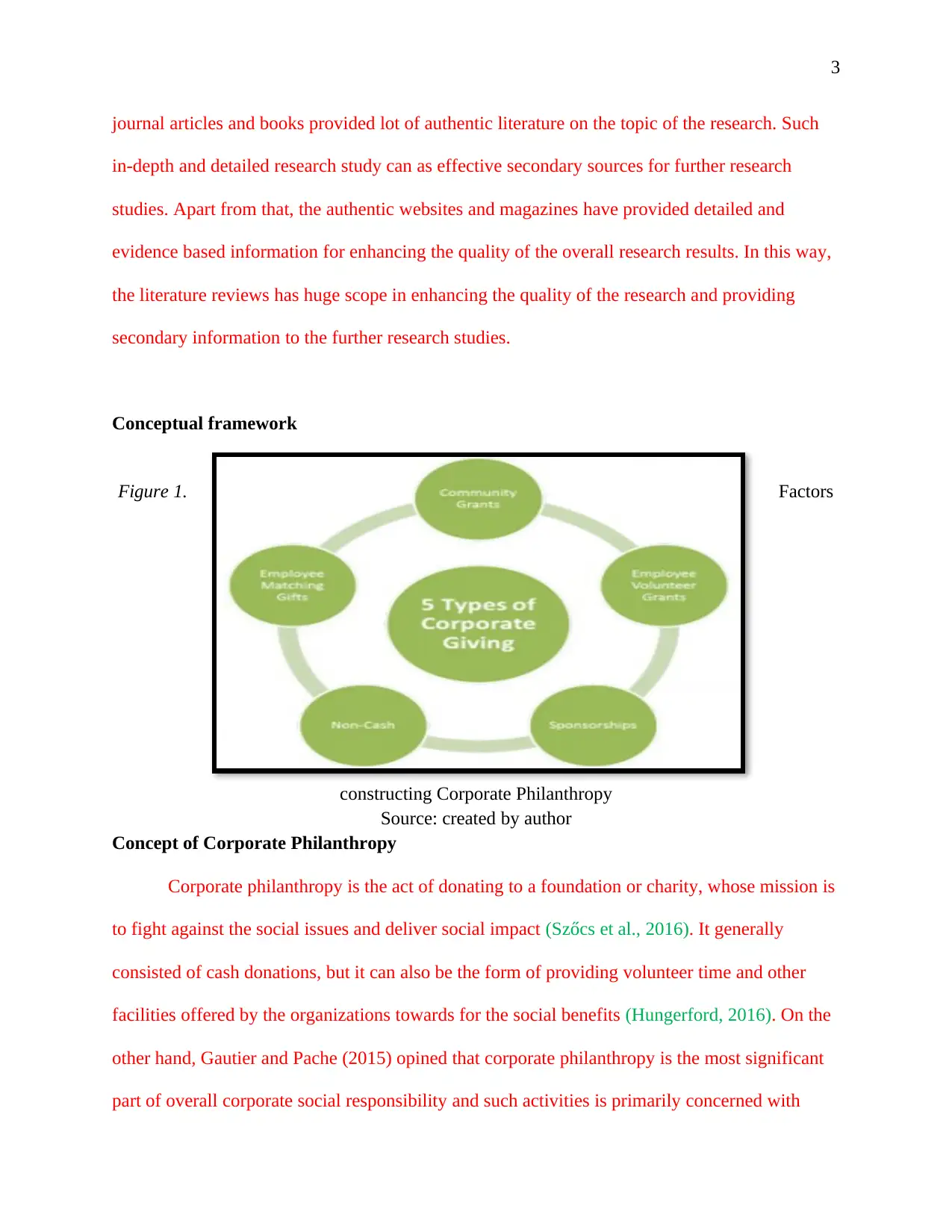
3
journal articles and books provided lot of authentic literature on the topic of the research. Such
in-depth and detailed research study can as effective secondary sources for further research
studies. Apart from that, the authentic websites and magazines have provided detailed and
evidence based information for enhancing the quality of the overall research results. In this way,
the literature reviews has huge scope in enhancing the quality of the research and providing
secondary information to the further research studies.
Conceptual framework
Figure 1. Factors
constructing Corporate Philanthropy
Source: created by author
Concept of Corporate Philanthropy
Corporate philanthropy is the act of donating to a foundation or charity, whose mission is
to fight against the social issues and deliver social impact (Szőcs et al., 2016). It generally
consisted of cash donations, but it can also be the form of providing volunteer time and other
facilities offered by the organizations towards for the social benefits (Hungerford, 2016). On the
other hand, Gautier and Pache (2015) opined that corporate philanthropy is the most significant
part of overall corporate social responsibility and such activities is primarily concerned with
journal articles and books provided lot of authentic literature on the topic of the research. Such
in-depth and detailed research study can as effective secondary sources for further research
studies. Apart from that, the authentic websites and magazines have provided detailed and
evidence based information for enhancing the quality of the overall research results. In this way,
the literature reviews has huge scope in enhancing the quality of the research and providing
secondary information to the further research studies.
Conceptual framework
Figure 1. Factors
constructing Corporate Philanthropy
Source: created by author
Concept of Corporate Philanthropy
Corporate philanthropy is the act of donating to a foundation or charity, whose mission is
to fight against the social issues and deliver social impact (Szőcs et al., 2016). It generally
consisted of cash donations, but it can also be the form of providing volunteer time and other
facilities offered by the organizations towards for the social benefits (Hungerford, 2016). On the
other hand, Gautier and Pache (2015) opined that corporate philanthropy is the most significant
part of overall corporate social responsibility and such activities is primarily concerned with
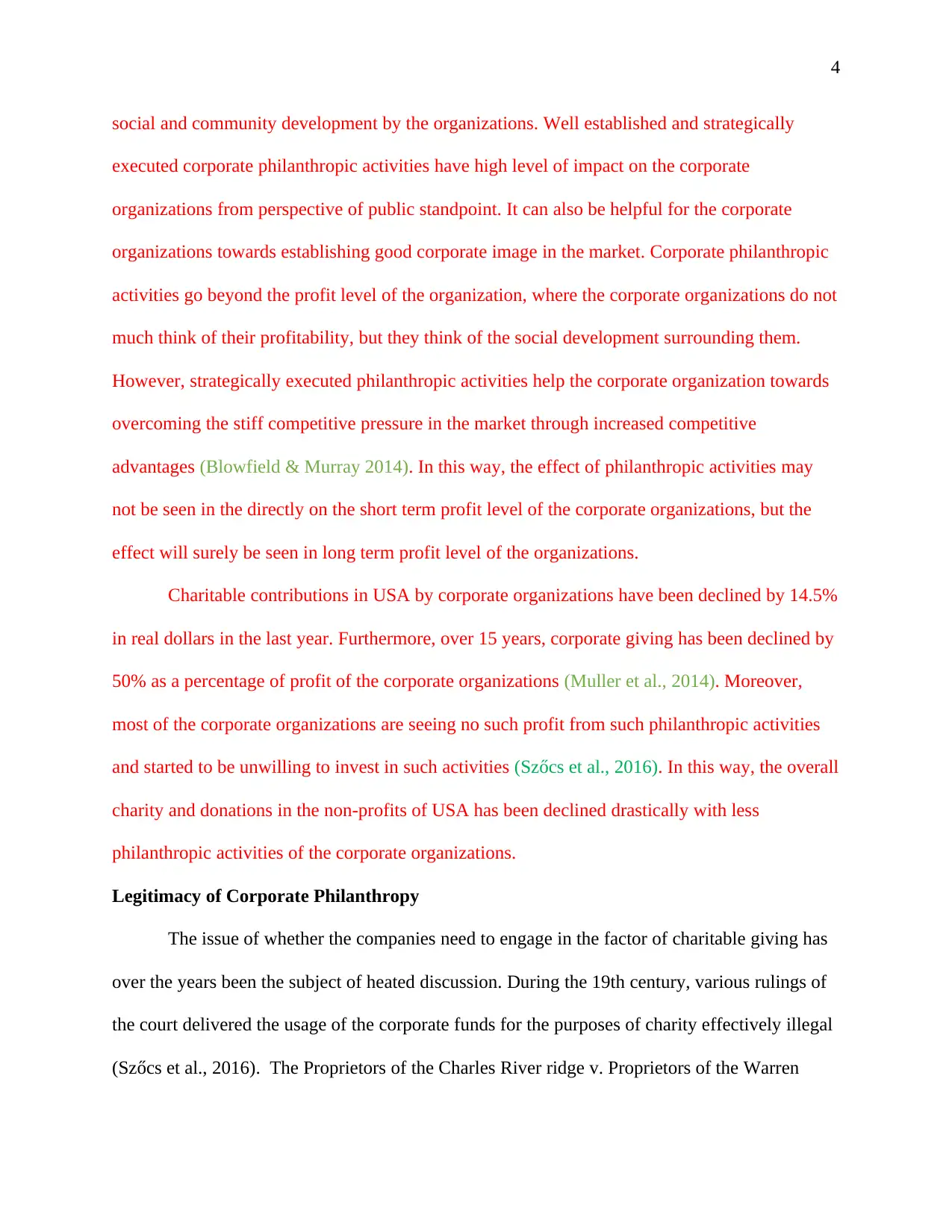
4
social and community development by the organizations. Well established and strategically
executed corporate philanthropic activities have high level of impact on the corporate
organizations from perspective of public standpoint. It can also be helpful for the corporate
organizations towards establishing good corporate image in the market. Corporate philanthropic
activities go beyond the profit level of the organization, where the corporate organizations do not
much think of their profitability, but they think of the social development surrounding them.
However, strategically executed philanthropic activities help the corporate organization towards
overcoming the stiff competitive pressure in the market through increased competitive
advantages (Blowfield & Murray 2014). In this way, the effect of philanthropic activities may
not be seen in the directly on the short term profit level of the corporate organizations, but the
effect will surely be seen in long term profit level of the organizations.
Charitable contributions in USA by corporate organizations have been declined by 14.5%
in real dollars in the last year. Furthermore, over 15 years, corporate giving has been declined by
50% as a percentage of profit of the corporate organizations (Muller et al., 2014). Moreover,
most of the corporate organizations are seeing no such profit from such philanthropic activities
and started to be unwilling to invest in such activities (Szőcs et al., 2016). In this way, the overall
charity and donations in the non-profits of USA has been declined drastically with less
philanthropic activities of the corporate organizations.
Legitimacy of Corporate Philanthropy
The issue of whether the companies need to engage in the factor of charitable giving has
over the years been the subject of heated discussion. During the 19th century, various rulings of
the court delivered the usage of the corporate funds for the purposes of charity effectively illegal
(Szőcs et al., 2016). The Proprietors of the Charles River ridge v. Proprietors of the Warren
social and community development by the organizations. Well established and strategically
executed corporate philanthropic activities have high level of impact on the corporate
organizations from perspective of public standpoint. It can also be helpful for the corporate
organizations towards establishing good corporate image in the market. Corporate philanthropic
activities go beyond the profit level of the organization, where the corporate organizations do not
much think of their profitability, but they think of the social development surrounding them.
However, strategically executed philanthropic activities help the corporate organization towards
overcoming the stiff competitive pressure in the market through increased competitive
advantages (Blowfield & Murray 2014). In this way, the effect of philanthropic activities may
not be seen in the directly on the short term profit level of the corporate organizations, but the
effect will surely be seen in long term profit level of the organizations.
Charitable contributions in USA by corporate organizations have been declined by 14.5%
in real dollars in the last year. Furthermore, over 15 years, corporate giving has been declined by
50% as a percentage of profit of the corporate organizations (Muller et al., 2014). Moreover,
most of the corporate organizations are seeing no such profit from such philanthropic activities
and started to be unwilling to invest in such activities (Szőcs et al., 2016). In this way, the overall
charity and donations in the non-profits of USA has been declined drastically with less
philanthropic activities of the corporate organizations.
Legitimacy of Corporate Philanthropy
The issue of whether the companies need to engage in the factor of charitable giving has
over the years been the subject of heated discussion. During the 19th century, various rulings of
the court delivered the usage of the corporate funds for the purposes of charity effectively illegal
(Szőcs et al., 2016). The Proprietors of the Charles River ridge v. Proprietors of the Warren
⊘ This is a preview!⊘
Do you want full access?
Subscribe today to unlock all pages.

Trusted by 1+ million students worldwide
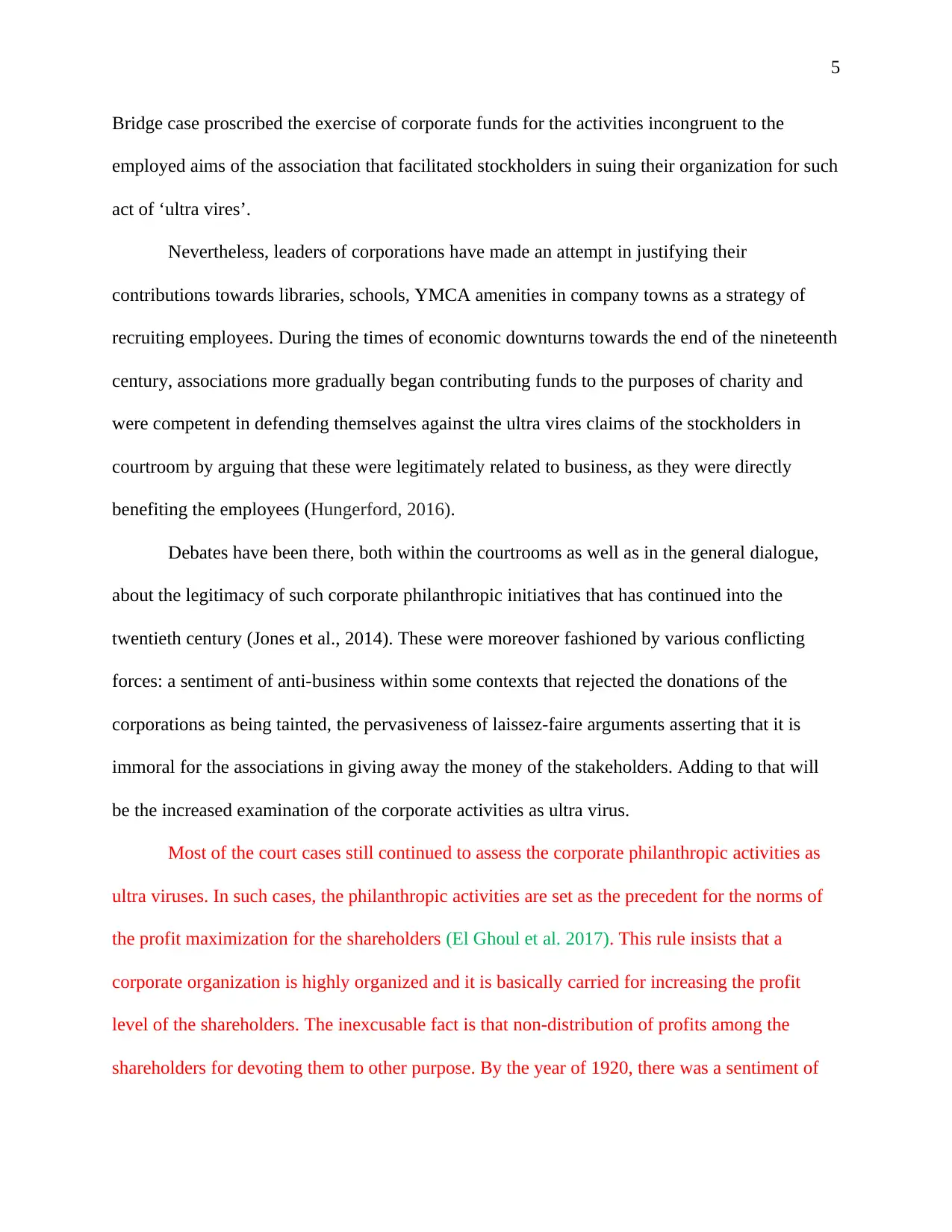
5
Bridge case proscribed the exercise of corporate funds for the activities incongruent to the
employed aims of the association that facilitated stockholders in suing their organization for such
act of ‘ultra vires’.
Nevertheless, leaders of corporations have made an attempt in justifying their
contributions towards libraries, schools, YMCA amenities in company towns as a strategy of
recruiting employees. During the times of economic downturns towards the end of the nineteenth
century, associations more gradually began contributing funds to the purposes of charity and
were competent in defending themselves against the ultra vires claims of the stockholders in
courtroom by arguing that these were legitimately related to business, as they were directly
benefiting the employees (Hungerford, 2016).
Debates have been there, both within the courtrooms as well as in the general dialogue,
about the legitimacy of such corporate philanthropic initiatives that has continued into the
twentieth century (Jones et al., 2014). These were moreover fashioned by various conflicting
forces: a sentiment of anti-business within some contexts that rejected the donations of the
corporations as being tainted, the pervasiveness of laissez-faire arguments asserting that it is
immoral for the associations in giving away the money of the stakeholders. Adding to that will
be the increased examination of the corporate activities as ultra virus.
Most of the court cases still continued to assess the corporate philanthropic activities as
ultra viruses. In such cases, the philanthropic activities are set as the precedent for the norms of
the profit maximization for the shareholders (El Ghoul et al. 2017). This rule insists that a
corporate organization is highly organized and it is basically carried for increasing the profit
level of the shareholders. The inexcusable fact is that non-distribution of profits among the
shareholders for devoting them to other purpose. By the year of 1920, there was a sentiment of
Bridge case proscribed the exercise of corporate funds for the activities incongruent to the
employed aims of the association that facilitated stockholders in suing their organization for such
act of ‘ultra vires’.
Nevertheless, leaders of corporations have made an attempt in justifying their
contributions towards libraries, schools, YMCA amenities in company towns as a strategy of
recruiting employees. During the times of economic downturns towards the end of the nineteenth
century, associations more gradually began contributing funds to the purposes of charity and
were competent in defending themselves against the ultra vires claims of the stockholders in
courtroom by arguing that these were legitimately related to business, as they were directly
benefiting the employees (Hungerford, 2016).
Debates have been there, both within the courtrooms as well as in the general dialogue,
about the legitimacy of such corporate philanthropic initiatives that has continued into the
twentieth century (Jones et al., 2014). These were moreover fashioned by various conflicting
forces: a sentiment of anti-business within some contexts that rejected the donations of the
corporations as being tainted, the pervasiveness of laissez-faire arguments asserting that it is
immoral for the associations in giving away the money of the stakeholders. Adding to that will
be the increased examination of the corporate activities as ultra virus.
Most of the court cases still continued to assess the corporate philanthropic activities as
ultra viruses. In such cases, the philanthropic activities are set as the precedent for the norms of
the profit maximization for the shareholders (El Ghoul et al. 2017). This rule insists that a
corporate organization is highly organized and it is basically carried for increasing the profit
level of the shareholders. The inexcusable fact is that non-distribution of profits among the
shareholders for devoting them to other purpose. By the year of 1920, there was a sentiment of
Paraphrase This Document
Need a fresh take? Get an instant paraphrase of this document with our AI Paraphraser
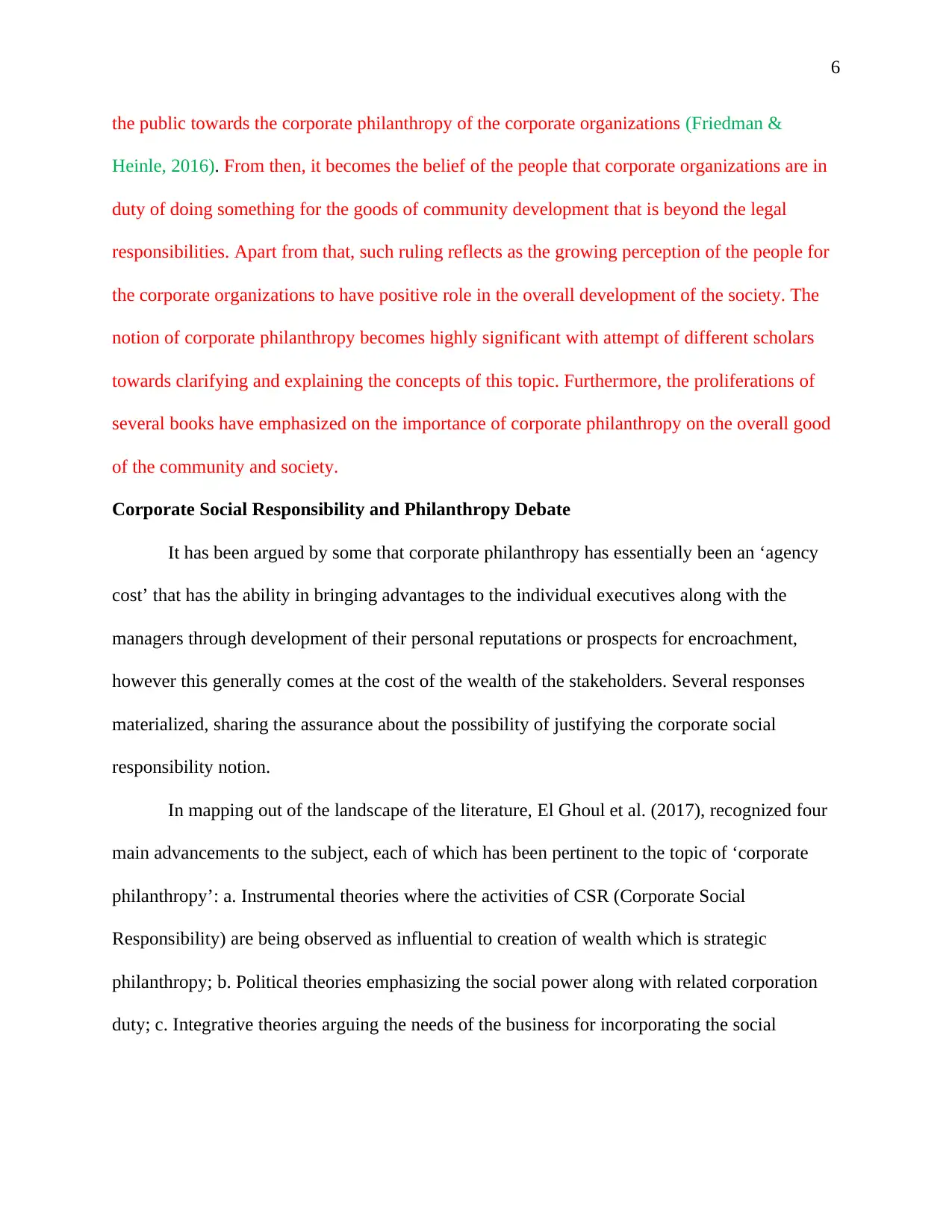
6
the public towards the corporate philanthropy of the corporate organizations (Friedman &
Heinle, 2016). From then, it becomes the belief of the people that corporate organizations are in
duty of doing something for the goods of community development that is beyond the legal
responsibilities. Apart from that, such ruling reflects as the growing perception of the people for
the corporate organizations to have positive role in the overall development of the society. The
notion of corporate philanthropy becomes highly significant with attempt of different scholars
towards clarifying and explaining the concepts of this topic. Furthermore, the proliferations of
several books have emphasized on the importance of corporate philanthropy on the overall good
of the community and society.
Corporate Social Responsibility and Philanthropy Debate
It has been argued by some that corporate philanthropy has essentially been an ‘agency
cost’ that has the ability in bringing advantages to the individual executives along with the
managers through development of their personal reputations or prospects for encroachment,
however this generally comes at the cost of the wealth of the stakeholders. Several responses
materialized, sharing the assurance about the possibility of justifying the corporate social
responsibility notion.
In mapping out of the landscape of the literature, El Ghoul et al. (2017), recognized four
main advancements to the subject, each of which has been pertinent to the topic of ‘corporate
philanthropy’: a. Instrumental theories where the activities of CSR (Corporate Social
Responsibility) are being observed as influential to creation of wealth which is strategic
philanthropy; b. Political theories emphasizing the social power along with related corporation
duty; c. Integrative theories arguing the needs of the business for incorporating the social
the public towards the corporate philanthropy of the corporate organizations (Friedman &
Heinle, 2016). From then, it becomes the belief of the people that corporate organizations are in
duty of doing something for the goods of community development that is beyond the legal
responsibilities. Apart from that, such ruling reflects as the growing perception of the people for
the corporate organizations to have positive role in the overall development of the society. The
notion of corporate philanthropy becomes highly significant with attempt of different scholars
towards clarifying and explaining the concepts of this topic. Furthermore, the proliferations of
several books have emphasized on the importance of corporate philanthropy on the overall good
of the community and society.
Corporate Social Responsibility and Philanthropy Debate
It has been argued by some that corporate philanthropy has essentially been an ‘agency
cost’ that has the ability in bringing advantages to the individual executives along with the
managers through development of their personal reputations or prospects for encroachment,
however this generally comes at the cost of the wealth of the stakeholders. Several responses
materialized, sharing the assurance about the possibility of justifying the corporate social
responsibility notion.
In mapping out of the landscape of the literature, El Ghoul et al. (2017), recognized four
main advancements to the subject, each of which has been pertinent to the topic of ‘corporate
philanthropy’: a. Instrumental theories where the activities of CSR (Corporate Social
Responsibility) are being observed as influential to creation of wealth which is strategic
philanthropy; b. Political theories emphasizing the social power along with related corporation
duty; c. Integrative theories arguing the needs of the business for incorporating the social
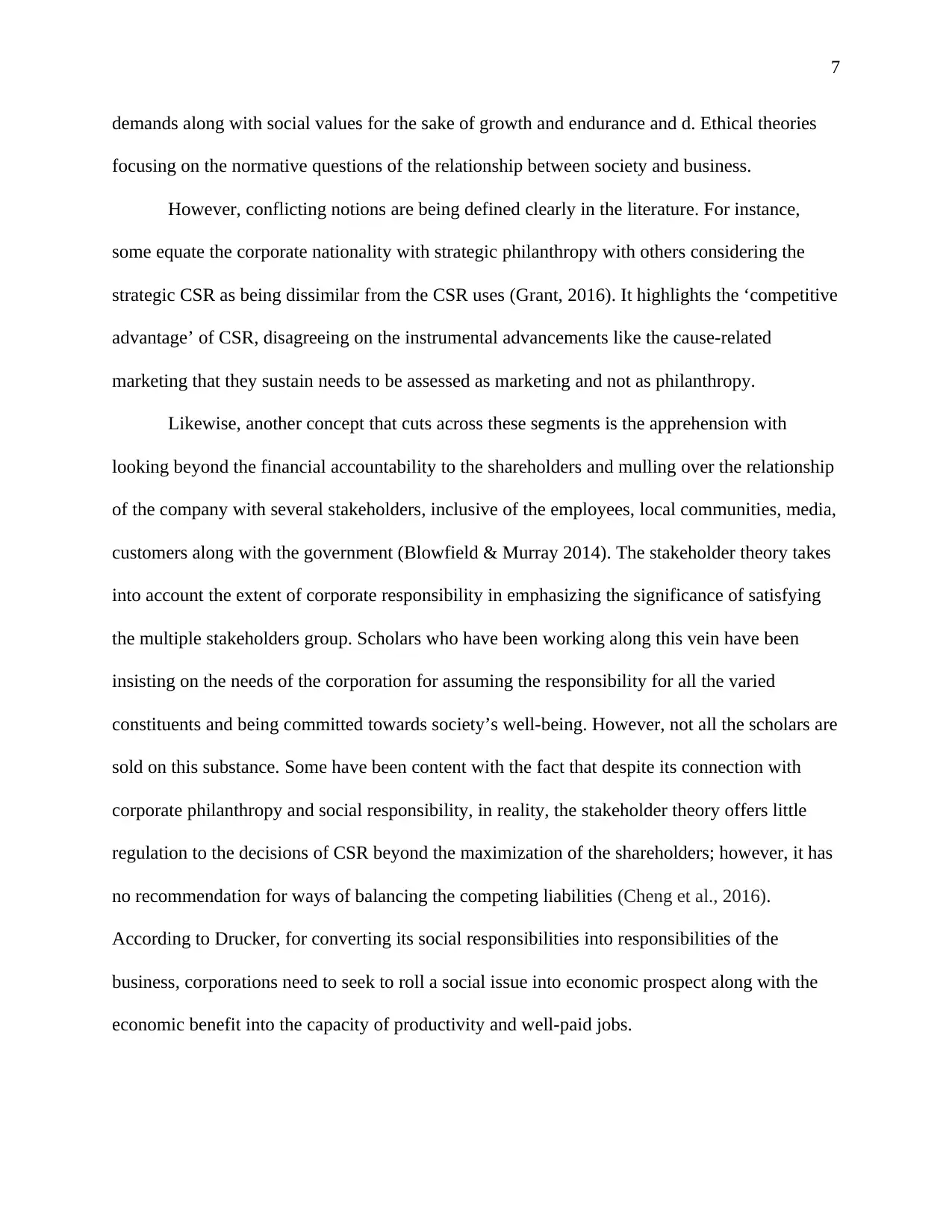
7
demands along with social values for the sake of growth and endurance and d. Ethical theories
focusing on the normative questions of the relationship between society and business.
However, conflicting notions are being defined clearly in the literature. For instance,
some equate the corporate nationality with strategic philanthropy with others considering the
strategic CSR as being dissimilar from the CSR uses (Grant, 2016). It highlights the ‘competitive
advantage’ of CSR, disagreeing on the instrumental advancements like the cause-related
marketing that they sustain needs to be assessed as marketing and not as philanthropy.
Likewise, another concept that cuts across these segments is the apprehension with
looking beyond the financial accountability to the shareholders and mulling over the relationship
of the company with several stakeholders, inclusive of the employees, local communities, media,
customers along with the government (Blowfield & Murray 2014). The stakeholder theory takes
into account the extent of corporate responsibility in emphasizing the significance of satisfying
the multiple stakeholders group. Scholars who have been working along this vein have been
insisting on the needs of the corporation for assuming the responsibility for all the varied
constituents and being committed towards society’s well-being. However, not all the scholars are
sold on this substance. Some have been content with the fact that despite its connection with
corporate philanthropy and social responsibility, in reality, the stakeholder theory offers little
regulation to the decisions of CSR beyond the maximization of the shareholders; however, it has
no recommendation for ways of balancing the competing liabilities (Cheng et al., 2016).
According to Drucker, for converting its social responsibilities into responsibilities of the
business, corporations need to seek to roll a social issue into economic prospect along with the
economic benefit into the capacity of productivity and well-paid jobs.
demands along with social values for the sake of growth and endurance and d. Ethical theories
focusing on the normative questions of the relationship between society and business.
However, conflicting notions are being defined clearly in the literature. For instance,
some equate the corporate nationality with strategic philanthropy with others considering the
strategic CSR as being dissimilar from the CSR uses (Grant, 2016). It highlights the ‘competitive
advantage’ of CSR, disagreeing on the instrumental advancements like the cause-related
marketing that they sustain needs to be assessed as marketing and not as philanthropy.
Likewise, another concept that cuts across these segments is the apprehension with
looking beyond the financial accountability to the shareholders and mulling over the relationship
of the company with several stakeholders, inclusive of the employees, local communities, media,
customers along with the government (Blowfield & Murray 2014). The stakeholder theory takes
into account the extent of corporate responsibility in emphasizing the significance of satisfying
the multiple stakeholders group. Scholars who have been working along this vein have been
insisting on the needs of the corporation for assuming the responsibility for all the varied
constituents and being committed towards society’s well-being. However, not all the scholars are
sold on this substance. Some have been content with the fact that despite its connection with
corporate philanthropy and social responsibility, in reality, the stakeholder theory offers little
regulation to the decisions of CSR beyond the maximization of the shareholders; however, it has
no recommendation for ways of balancing the competing liabilities (Cheng et al., 2016).
According to Drucker, for converting its social responsibilities into responsibilities of the
business, corporations need to seek to roll a social issue into economic prospect along with the
economic benefit into the capacity of productivity and well-paid jobs.
⊘ This is a preview!⊘
Do you want full access?
Subscribe today to unlock all pages.

Trusted by 1+ million students worldwide
1 out of 58
Related Documents
Your All-in-One AI-Powered Toolkit for Academic Success.
+13062052269
info@desklib.com
Available 24*7 on WhatsApp / Email
![[object Object]](/_next/static/media/star-bottom.7253800d.svg)
Unlock your academic potential
Copyright © 2020–2025 A2Z Services. All Rights Reserved. Developed and managed by ZUCOL.




